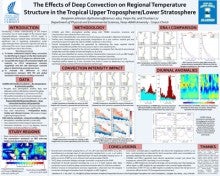Quantifying the Impact of Tropical Deep Convection on the UTLS Temperature Structure using COSMIC Observations
Benjamin
Johnston
Texas A&M University - Corpus Christi
Poster
Understanding the impact of deep convection on the thermodynamic structure of the tropical upper troposphere/lower stratosphere (UTLS) is vital because convection and temperatures play an important role in regulating stratospheric water vapor through direct convective injection and in enhancing the presence of thin cirrus clouds, both of which play a significant role in the climate. This research quantifies the UTLS vertical temperature structure changes near deep convection over the Pacific Warm Pool (PWP) and the Tropical Atlantic Continental and Oceanic (TACO) region. The deep convection observed from the Tropical Rainfall Measuring Mission (TRMM) satellite are collocated with high vertical resolution temperature profiles from the COSMIC GPS Radio Occultation satellites along with ERA-Interim reanalysis from 2007 to 2011. COSMIC and ERA-Interim observe warm temperature anomalies (0.2 to 0.8 K) within 10-14 km, then transitioning to a layer of cool anomalies (-0.4 to -1.5 K) within 14-17 km. Above the cold-point tropopause (CPT), warm anomalies (<1 K) are observed for oceanic convection, whereas cool anomalies are seen for land convection within 17-20 km. The amplitude of temperature anomalies increases for deeper convection, marked by higher 20 dBZ radar echo-top heights or colder infrared cloud-top temperatures. COSMIC also observed enhanced UTLS diurnal temperature variations of about 0.2-0.3 K in both regions near the deep convection. ERA-Interim shows generally good agreement with COSMIC on the UTLS temperature anomalies near deep convection, but displays larger differences above the tropopause, especially near land convection.

Poster PDF
Abstract file